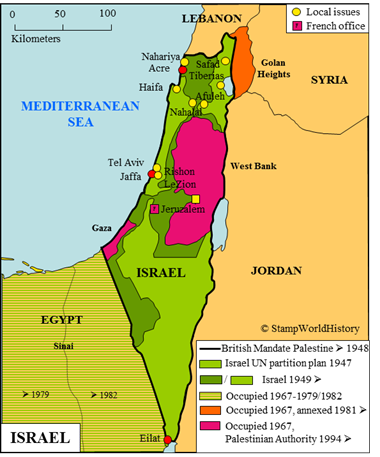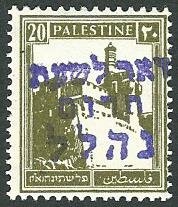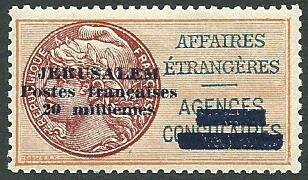ישראל

Israel
Quick reference
General issues: Republic 1948-Present
Country name on general issues: ישראל ,דאר עברי, Israel
Special issues:
- Postmaster issues: Haifa & Jerusalem, Tel Aviv 1948
- Local issues: Afuleh, Nahalal, Nahariya, Rishon le Zion, Safad, Tiberias 1948
- Foreign offices: France 1948
Related issues:
- Egyptian occupation of Palestine 1948-1967
- Indian forces in Egypt 1965
- Jordanian occupation of Palestine 1948-1949
- Palestinian Authority 1994-Present
Currency: 1 Pound = 1000 Mils 1948-1949, 1 Pund = 1000 Pruta 1949-1960, 1 Pound = 1 Agorot 1960-1980, 1 Shekel = 100 Agorot 1980-1985, 1 New Shekel = 100 Agorot 1985-Present
Population: 1 066 000 in 1949, 8 059 000 in 2013
Political history Israel
From Ottoman rule to mandated territory

Dome of the Rock and Western Wall
Israel is located in the Middle East, western Asia. In the 19th century Israel, at the time known as Palestine, was part of the Ottoman Empire. In 1917, during WWI, the territory is occupied by the British who establish a military administration. In 1920, civil administration is established and in 1922 the League of Nations formally approves of Palestine to be administered by Great Britain as a mandated territory. The borders have, at that point, already been determined through the treaty of Sèvres signed in 1920, by which the British and the French agreed upon their respective spheres of influence in the former parts of the Ottoman Empire in the Middle East.
Growing Jewish influence
Palestine has long had a largely Arab population. The end of the 19th century, however, sees the first wave of Jewish emigration to Palestine. Increasing antisemitism in Europe causes more Jews to emigrate to Palestine in the early 20th century. The Jewish emigration will reach its peak after the Holocaust in WWII.
Towards the end of the 19th century, Zionism gains influence. Zionism is a movement aiming at the establishment of a Jewish state. A major step in achieving this aim is taken in 1917 with the Balfour declaration, in which Great Britain recognizes the right of the Jewish people to a ‘national home’. The establishment of a ‘national home for the Jewish people’ becomes an important element in the British mandate over Palestine.
The road to independence
During the British mandate, tension rises between the Arab and ever growing Jewish population groups in Palestine. After WWII, the United Nations, in 1947, present a plan for the establishment of both an Arab and a Jewish state in Palestine with Jerusalem under international control. The plan is rejected by the Arab population and civil war breaks out.
When, in 1948, the British mandate ends, the Jewish state is proclaimed as the republic of Israel. The same day, a number of Arab countries in the region declare war on Israel. The war ends in 1949 with a cease fire agreement. Part of the cease fire agreement is the establishment of provisional borders. Compared to the United Nations plan from 1947, Israel gains territory. The remaining territory is put under control of Egypt[1]Gaza and Jordan[2]The West Bank . Many of the Arabs in the country – subsequently called Palestinians – seek refuge in Gaza, on the West Bank and in neighboring Jordan and Lebanon.
War
In coming years, Israel and the Arab countries will engage in war several times. In 1956, Israel supports Great Britain and France in the Suez crisis and occupies Gaza and the Sinai. Under United Nations pressure, Israel withdraws, in 1957, after which the United Nations Emergency Force is deployed in Gaza and the Sinai. UNEF will be active in the region until 1967. In 1967, the Six Day War breaks out. Israel is militarily superior to the Arab countries. The war ends in Israeli occupation of Gaza and the Sinai, the West Bank and the Golan Heights – part of Syria. In 1973, war breaks out again. This Yom Kippur War ends in a status quo ante bellum. As of 1978, Israeli forces are deployed several times in Lebanon that, at the time, serves as a base for Palestinian militias fighting Israel.
The road to peace
At the end of the 1970’s, diplomatic initiatives aimed at peace are successful. In 1979 a peace agreement is signed with Egypt. A peace agreement with Jordan follows in 1994. Among other things, the borders are agreed upon. Egypt and Jordan relinquish claims they may have had on Gaza and the West Bank, these territories to become part of the negotiations on the formation of a Palestinian state.
The Palestinian Authority
The Palestinians have organized themselves, in the 1960’s, in the Palestinian Liberation Organization – PLO – that initially focuses on an armed struggle against Israel. In the 1970’s, the PLO approach becomes more political. After the peace agreement in 1994, the Palestinian Authority is formed that gains a certain amount of self government in Gaza and on the West Bank. Israel, in 2005, fully withdraws from Gaza – although it still controls the Gaza borders and airspace and has repeatedly invaded Gaza as a reprisal for air attacks from Gaza. After internal conflicts, Hamas takes over power in Gaza at the expense of the Palestinian Authority. Internationally, there is much support for a fully independent Palestinian state. A solution that accommodates both the Israeli and the Palestinians has yet to be found.
Postal history Israel

Torah scrolls
Ottoman rule and mandated territory
In Ottoman times, the stamps of Turkey were used in what is currently Israel. Several countries – Austria, Egypt, France, Germany, Italy and Russia – had offices abroad in Acre, Haifa, Jaffa and Jerusalem. From 1917, stamps issued by the British military administration are used, stamps inscribed ‘E.E.F.'[3]‘Egyptian Expeditionary Force’ . These issues are succeeded by issues from the civil administration. Overprints on the E.E.F. issues read ‘Palestine’ in Arabic, English and Hebrew. Later definitives are issued, also inscribed ‘Palestine’ in Arabic, English and Hebrew.
Provisional issues
When the British leave Palestine in April 1948, a gap in the transfer of the postal service necessitates the issue of provisional stamps, until the declaration of independence of the state of Israel in May 1948 – the so called ‘Interim Period’. Postmasters in Haifa, Jerusalem and Tel Aviv overprint labels issued by the Jewish National Fund for fund raising purposes with ‘דאר’ which is transliterated as ‘Doar'[4]‘Mail’ . The Haifa and Jerusalem postmasters use a black overprint, the Tel Aviv postmaster a violet or red overprint. In addition, provisional stamps are issued in several cities on local initiative: in Afuleh, Nahalal, Nahariya, Rishon le Zion, Safad and Tiberias. These local issues may be both overprints on previous issues of the British administration and issues of local design and print. Finally labels of the Jewish National Fund are known to have been accepted without overprint. These are recognized by the inscription ‘קרן קימת לישראל’ or ‘Jewish Nation Fund’.[5]These provisional issues are referred to by Michel, none of the catalogs has listed the issues.
In the same period, the French consulate in Jerusalem issued provisional stamps. These are overprints on consulate revenue stamps where the text ‘Agences Consulaires’ is barred and an additional overprint reads ‘Jerusalem, Postes Françaises’ and a new face value. Also stamps of France overprinted ‘Jerusalem’ and a new face value.[6]The issues from the French consulate are listed in Michel and Yvert & Tellier.
General issues
The first set for general use was issued two days after the declaration of independence on May 16, 1948. The set is inscribed ‘Doar Ivri'[7]‘Hebrew mail’ , the inscription being in Arabic and Hebrew characters. The set bears no country name, allegedly because the government still had to decide on the formal name of the country. Subsequent issues are inscribed Israel in Arabic, English and Hebrew. A characteristic of Israeli stamps is that they are issued with an inscribed tab, stamps with tab have a higher value than those without.
Gaza and the West Bank
When the provisional borders were established in 1949, Gaza came under Egyptian control and the West Bank under the control of Jordan. Egypt has issued stamps for use in Gaza from 1948 until 1967. The Indian forces deployed in the Gaza and the Sinai as part of the United Nations Emergency Force, after the Suez crisis in 1956, issued field post stamps in 1965. Jordan has issued stamps for the West Bank in 1948 and 1949. The West Bank was annexed by Jordan in 1950 and Jordanian stamps have been used from 1950 until 1967. After the Israeli occupation in 1967, Israeli stamps came into use both in Gaza and on the West Bank. As of 1994, Israeli stamps are used concurrently with issues of the Palestinian Authority. In Gaza, Hamas has issued stamps since 2009. These are recognized by the Palestinian Authority for use on domestic mail since 2014.[8]The Hamas issues are currently not listed by the worldwide catalogs.
Album pages
← Previous page: IraqNext page: Japan →









